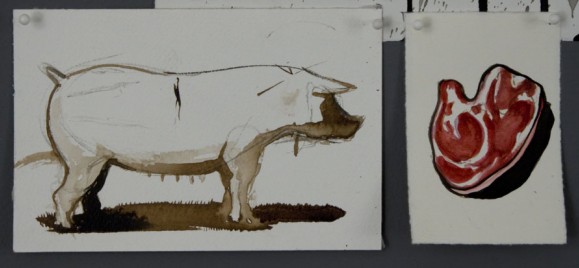Brett DeFries, "The Great American Novel"
A response to James Gouldthorpe
The heart as it looked at the sow
whose it was
the rifle butt above it
the milker underneath the dripping
house
the dripping revolver
the eyeless folks
the eyeless beasts
all synchronize to kill "and then"
"and then"
which dialogue loves
so the sow doesn't speak
she faces
her heart
the gun doesn't melt
born strangled
the duck never lived
the legible words
(the zoom not
enough)
"competitor"
"match"
but there is no sequence
there is
no sight
there is no speech
and there is

Process Notes
What strikes me about Gouldthorpe's fascinating "Great American Novel" is not narrative but simultaneity. That each image is all-at-once with the others, no one depending on another's cause, indicates that any narrative is one the viewer must supply to fill the causal gaps. Did the men beneath the revolver pull its trigger to kill some person or animal? Did an unpainted someone kill those men with the revolver? Or is the men's only relationship to the revolver one of nearness on a wall of painted images? Did the sighted rifle kill the sow? That would be strange and superfluous, though what I see is a sow facing a heart (its own?) beneath a sighted rifle. Rather than suggest a narrative, I did my best to let the painting—not it's representation—narrate itself. When I give up the desire to narrate "The Great American Novel," I see things existing simultaneously with others, no one acting on an other, but all of them acting on me, the also active viewer.
Responses to James Gouldthorpe's Work
Brett DeFries
Brett DeFries' poems have appeared or are forthcoming in FENCE, Colorado Review, New Orleans Review, Konundrum Engine Literary Review, Best American Experimental Writing (Omnidawn 2014), and elsewhere. A chapbook was published by New Delta Review in 2012. He is currently a PhD candidate in English literature at the University of Iowa.